|
ANIMAL
ITEMS:
Alaska Carvings & Travels
Alaska
Artifacts
Animal Carvings-Other
Australian
Art
Bronze Works
Bug & Crab Specimens
Exotic Leather Accessories
Gator Items
Gem Animals
Narwhal Tusks
Parasite
Wood Carvings
Safari Animal
Mounts
Sawfish bills
Shark Items
Shark Jaws
Tagua Nut Carvings
Teak Carvings
JEWELRY
ITEMS
Amber Items
Brooches
Cameos
Czech
brooches
Dichroic Glass
Jewelry
Earrings
Eyeglass Holders
Fairy Stone Crosses
Hatpins
Key chains
Maori Fish Hook Necklaces
Music
Jewelry
Necklaces
Opals &, Ivory Items
Pendants
Rings
Titanium
Jewelry
Vintage
Jewelry
FOSSIL ITEMS
Cave Bear Fossils
Dinosaur
Fossils
Mammoth
Fossils
Fossils-Others
Poop Fossils
Poop-Moose & Deer
Fossil Shark Teeth
CLOSEOUT
SALES:
Marbles
Closeout
Sales-Other
ROCK ITEMS
Meteorites
Rocks & Mineral-Other
OTHER COOL
STUFF FOR SALE
Alien Gifts
Boxes boxes
Gemstone
skulls
Indian
Artifacts
Medallions & Coins
Swords,
Daggers, Knives
The Weirdest
Zoo
books & Books
HUMAN
INTEREST
About Us
Cool
Customers
Jesse Nusbaum, Artist
Latest
Travels
2013 Travel America
Newsletter
Support Our Troops
Tina Memorial
Zany & Fun
FOLLOW us on TWITTER for
special DISCOUNTS



| |
You Are On: The Weirdest Page 1
| THREE
PAGES of the WEIRDEST STUFF on the PLANET
Headers on each page give guidelines of what you'll find, plenty of surprises! Keep your sense
of humor, and enjoy the ride... |
|
PAGE
1: Moose poop ornaments, coral; emerald beetle brooch and earrings,
Cassowary bone dagger, Silver wire tree, Replica Elephant tusk pillars, Boar's tusk
necklace; largest Cave bear skull, gator foot coffee mugs, giant cave
crystal, Paddlefish bill, Kangaroo paw back scratcher, sting ray skin, Albino Chinese
box turtle, carrier shell, Boar's
tooth cork screw, Boar's teeth, Hippo tusk bottle opener, Water Buffalo letter
opener, Water Buffalo letter opener/knife, Gemsbok/Oryx horn slices, Yak
tooth necklaces, Coyote tooth necklaces and tooth with claw necklaces,
Coyote claw earrings, Water buffalo tooth necklaces and
earrings, badger
claw necklaces, Sperm whale tooth necklace, Dinosaur Bone House!, Mr. Turtle, shrunken
heads, buffalo vertebrae, three-eyed
alligator head AND the world's only deformed gator head collection, Oosik,
Ostrich, stuff from our "weird museum", glass sponge,
heart cockle shell, Elephant teak trunk carving, brain and mushroom coral, fossil mud, and more!
PAGE 2:
Dinosaur embryo, Penis gourds, Frog Nesting doll, Amethyst stalactite,
Ammonite jewelry, scorpion, Jade Pillowcases, Shark in a bottle,
Giant shark tooth, Mystery ivory, snake bite boxes,
shark skin, fossil turtle poop, Fossil hamburger, fossil tree
branches & a mystery rock, and more!
PAGE 3:
Taxidermy Newborn Deer fawn, Skeletons of: tortoise, royal python
eating shrew; Black scorpions, frog, rat, Skeletons of: Eastern painted
turtle, cottonmouth snake, twig snake, Western Diamondback rattlesnake,
White throated monitor, Gila monster, weasel attacking mole, Mamushi
venomous snake, four horned ram photo, croc monitor, Gar fish, spider crab
photo, shark made of fossil shark teeth, giant shell, hog island boa with rat skeleton,
gimungous iguana, giboon viper skeleton, Pterois Volitans fish skeleton,
Rock Python eating Uromastyx Lizard, Ugly
Face Pottery
PAGE 4:
A "virtual tour" of the Ripley's Believe it or Not Museum in
Myrtle Beach, SC |
| JUST
WHEN YOU THOUGHT YOU'VE SEEN EVERYTHING!
JUMBO MOOSE POOP
CHRISTMAS ORNAMENTS
(or PIN/PENDANT) on
Victorian reproduction brass
Celebrate
this Year with some real HUMOR
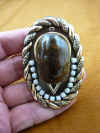

Link here to POOP
Fossils Page
1
|
|

This is an exquisite specimen of brain coral we acquired (April
2003)...but this is no ORDINARY coral .. this is a coral with a moral - Glenn says behind every BRAIN (sarcastically
speaking)...there's a....(see the bottom of the page...)
|
| EMERALD
BEETLE

Talk about being green, why not wear a bug?
What's so weird about that? Well, it's an Emerald Beetle from
Thailand, about 1-1/2" long.
The Thai people catch them and EAT
THEM. They pull off the wings and scoop out the nutty flavored white meat
- the long-fingered ladies in particular scoop the meat out easily with their
nails.
These beetles died naturally after reproducing,
then are made into pins with brass pieces with legs, glued to
the bottom, and then sold as lovely insect jewelry!

How's that for weird! We now have them
available! |
| EMERALD
BEETLE BROOCHES
Average 1-1/2" long
Stock photo (3 available)
$19 ea. |



#W-1
|
| LARGE
EMERALD BEETLE
WING EARRINGS
Average 2" long wings, on silver color
French wires
Stock photo (17 pairs available)
$24/pair |

#W-1-A
|
| PETITE
BEETLE WING EARRINGS
Average 1 to 1-1/4" long wings, on silver
color hypoallergenic French wires
Individually photographed
$20/pair |

#W1-B2 |
 #W1-B3 |
|
 #W1-B5 |
 #W1-B6 |
|

#W1-B9 |
 #W1-B11 |
CASSOWARY BONE DAGGER, PAPUA NEW GUINEA
Real Cassowary bird tibia leg bone (one side cut to the hollow inner bone,
with traditional knotted hood design, made of twined bark string and seed
beeds) made as a ceremonial dagger with real cassowary feathers tassel, from
Papua New Guinea (Irian Jaya), made by Asmat Tribesmen. We estimate the age
to be at least 50 years old.
Here is an information site about this
item:
http://www.art-pacific.com/artifacts/nuguinea/weapons/bneknife.htm
$299 each |
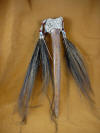
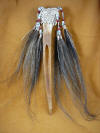





#W-1-C
14 long x 2-1/2 across knotted hood, x 1-3/4 deep
(across knotted hood); Bone itself is 1-1/8 wide x 3/4 deep. |
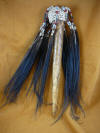
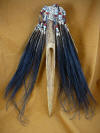





#W-1-D
15 long x 2-3/4 across knotted hood, x 1-3/4 deep
(across knotted hood); bone itself is 1-1/2 wide x 7/8 deep. |
|
EVER
SEE A SILVER TREE BEFORE?
Made of twisted sterling silver wire, on a
solid rock base, hung with numerous little silver bells. Hand made
by a jewelry teacher whose class Glenn took. Measures 21" tall
and 21" wide. A one-of-a-kind item!
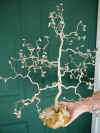
#W-1-M $300.00
SOLD |
|
GIRAFFE
LEG BONE
Genus and species: Giraffa camelopardalis
(wild)
This is a modern giraffe femur bone, product
of Africa. Measures 21-1/2" long x 8-1/2" widest socket
end, 3" across middle of bone
Weight: 8 lbs 15 oz. Not endangered, but
we will not ship outside the U.S.


  
#W-GIR-1 $345
SOLD |
|








TOP



#W-GIR-2
Genuine Giraffe Metatarsal bone - toe bone, not
a leg bone, though it operates as a lower leg. It has been carved on
one side with 3 walking elephants and a grove of trees; no carving on
back, flat on bottom, cut flat on one end.
Measures 25-1/4" long x 5" widest on
the ends, 2" widest in the middle, x 2" tall. On metal
rods drilled into a heavy, sturdy ironwood polished base, flat on
bottom. Natural crack along the top is stable. Stands
8-1/2" high overall with base. Not signed. African work.
$825 SOLD
|
|














#W-GIR-3
Genuine
Giraffe rib bone, scrimshawed with Gemsbok rutting and grazing and Zebras
grazing. Signed "Bekie Mcube" as close as we can
tell. Small wood stand on one end with metal insertions into end
which is a cap of bone; cut on the other end so it stands by itself.
Linear
measurement 29-1/2"; curved measurement 32-1/2"; 2" tallest
part of the rib in center, x 1" thickest. Stands 8" tall
at the center. A beautiful piece.
$975
|
|











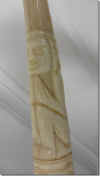
















#W-GIR-4
Ceremonial pipe made of giraffe (or perhaps
camel) bone (though
it is not hollow throughout like a usable pipe), shaped like a tusk though
it is bone. It is in two pieces, the pin between the two is missing. The
other sections have been pinned together with bone pins. Crowned
king head in the front (hole at the bottom) and images of people praying, and animals (lizards, snakes, rabbits),
and a square man's face on the side.
Measures 25" long following
curvature, x 1-1/2" widext, x 7" tall $2750 |
|
THE LARGEST CAVE BEAR SKULL
EVER EXCAVATED from
the Caves of Romania
(Ursus spelaeus)

A regular black bear skull looks like a weasel
skull when compared to this giant. Measures 20-7/8" long x 13-1/8" wide x 11-5/8" tall.
$16,500
SOLD Read
the rest of the details, and more cave bear fossils available, on the CAVE BEAR
FOSSILS page, link below: Cave Bear Fossils |
| Guess
what this is...is this a shoe insole? No. A fly catcher?
Nope. Give up? Check the yellow box at the bottom of the
page for the answer. |
 |
| EVER
SEE A
GATOR FOOT COFFEE MUG?
What a hoot of a
conversation piece, and functional too, if you wish, as a mug, beer stein or even a pen
holder for your desk. Available exclusively from us. Mug is
black ceramic or clear glass. Hand wash only.
This size comes from MONSTER gators over 11
feet long to get this size. Priced as shown.

Go to the GATORS PAGE 3, item #G343 series to
view them ALL, with the prices:
Gator Page 6
|
| CAVE
CRYSTAL

#W-2. Giant
cave crystal from China. Size is 15" high x 24" wide x 4
1/2" thick. Solid, and an incredible natural work of art.
$2,100 plus actual shipping |
| RARE
AMERICAN
PADDLEFISH or SPOONBILL
BILL
(Polyodon spathula)
The
paddlefish is a popular sport fish with a distinctive snout that's
elongated and flattened into the paddle shape, for which is it named. The paddle is used to detect prey, and
to migrate
back to spawning grounds. Paddlefish is also the oldest living
species in North America.

According to fossil records, it's OLDER
THAN THE DINOSAURS!
|

 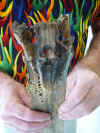
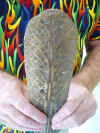
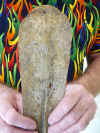 #W-3 Genuine Paddlefish bill is 3-1/4" wide
x 16" long, modern not fossil
$400
SOLD
|
| Below is a LARGE MOOSE
JAW prepared by our friend Bob in Maine as a dreamcatcher for Glenn, with one
of Glenn's favorite Auriculitis fossil shark teeth in the center, two
sharks hand painted on both sides of the jaw. This one is not for
sale (it hangs on display in his office, thanks Bob!), but inquire about
purchasing another if you wish.
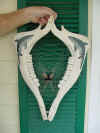
|
| Kangaroo
Paw BACK SCRATCHER |



#W-900-100 Genuine kangaroo paw back
scratcher! 13" long, partially
wrapped and sewn roo hide from paw down the bamboo stick about 6". Keep in
mind the kangaroos are hunted by government permit only, if they did not keep
the numbers down they would starve in the winter, which is worse. Then
100% of the roo is recycled (the meat is eaten, the hide is used, even the feet
as you see here, much as deer here in the U.S.) Information card comes
with it.
$34.00 SOLD
OUT
|
| Link
to kangaroo scrotum pouch coin purses and keychains
ON
Exotic
Leather Accessories |
| The
birthday party was great! The birthday girl thought the kangaroo
scrotum pouch was hysterical. So did everyone else! Here's Chris showing
off her most unusual gift for her 'memorable birthday' celebration in
South Carolina...

|
| MYSTERY
SKIN... |
|
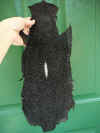

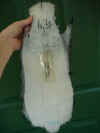
#W-4-B. Bet you'll never guess what
kind of skin this is (shown top, bottom and close up, measures 19"
long x 7" wide) $59.00
SOLD
OUT
STINGRAY! It is tanned,
dyed black, the center left natural, and is mainly used in making
motorcycle seats and even purses. The shiny, pebbly, durable surface is such
a high quality! |
| RARE
ALBINO CHINESE BOX TURTLE (Cistoclemmys flavomarginata) TAXIDERMY
These turtles are f |



 #W-5 This
is one of our new treasures, a taxidermy of an Albino Chinese Box Turtle,
6-1/2" long x 4" wide x 1-5/8" tall, shell is 4-3/4"
long x 3-1/2" wide. $220
SOLD |
| Pallid
CARRIER
SHELLS
(Masters of disguise)
(Xenophora Palidula, Phillipines)
Heidi's favorite, the Master of
Disguise in the shell family. As they grow, they attach a variety
of objects to themselves, ranging from dead shells and coral, to pebbles
and even bits of garbage left by humans (see the glass bottle top in the
photo below, from a shell book). These items slowly twirl to the center top of the
shell as the shell grows larger. A deepwater shell in most of the
world's warm seas

$39 each |

#W-7-A |

#W-7-C |

#W-7-E |
|
Boars
Tusk/Rattan
Bontoc
Necklace
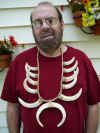
Head hunter warrior's
trophy necklace
NEW, HAND MADE, 12 natural,
genuine boars tusks woven on a hand made rattan necklace, from the
mountain province of Bontoc near the Banaue rice terraces on the Island of
Luzon, Philippines.
Bontoc means bun
(heap) and tuk (top), together meaning mountains, referring to
the people of the Mountain Province in the Philippines which actually
covers 4 provinces (Benguet, Ifugao, Mountain Province- formerly sub
province Bontoc - and Kalinga-Apayao).
This was traditionally considered
a headhunters warriors trophy; Igorot groups formerly practiced
headhunting and male dancers wore these at the atos head-taking
ceremony. Some were adorned with human hair from a victim(headhunting
ended in the 1930s).
It is the stylish bachelor young men who wear
boars teeth necklaces (and armbands called abkil) today, to show their
single, available status. The Ifugao believe that wearing this necklace
gives them power, strength and speed of the boar. It is worn with the boars
tusks pointing away from the breast, not towards it (like in Native
American bear claw necklaces).


Reverse side also shown here:

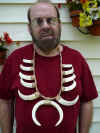
#W-BOAR-1. Teeth are from 6.5" long at the
bottom to 3" long at the top, measuring along the curve. Rattan
necklace is 32" long (no clasp, it just fits over the head). A
special weird thing to display, wear and own!
(4 are available)
$395 |
| WART
HOG SKULLS
Phacochoerus aethiopicus
Product of Africa, Skull and tusks as
described |




#W-BOAR-10
Skull measures 13" long x
7" wide x 7" tall; 7" tusks
$265 |




#W-BOAR-11
Skull measures 13-1/2" long x
7" wide x 6" tall; 5" tusks
$255 |




#W-BOAR-12
Skull measures 14-1/2" long x
7-1/2" wide x 8-1/2" tall; 9" tusks
$275
SOLD - Bill |
|
LINK
TO OTHER BOAR ITEMS FOR SALE
|
| BOAR'S
TOOTH CORKSCREW |


 #W-9-1
Agate on the wide end, brass
corkscrew
Tooth is 4 linear
measurement, 5 curved
Carved elephant in tooth
$39 |
|
HIPPO TUSK TOOTH BOTTLE OPENER
Heavy duty brass opener,
natural hippo tooth with wood capped end, 6 LONG, measured linear overall,
tooth itself from cap to tip is 4-7/8
Carved with two elephants, toasted
to highlight carving
$85
|



#W-11-1
|
|
WATER BUFFALO HORN OR BONE LETTER OPENER (Africa)
Heavy duty brass opener,
natural hippo tooth with wood capped end, 6 LONG, measured linear overall,
tooth itself from cap to tip is 4-7/8
Carved with two elephants, toasted
to highlight carving
Individually priced
|



#W-12-1
Water buffalo bone, wood capped both ends, carved Water
buffalo head
HANDLE 2-3/8 long x 1-1/2 wide x 1 thick
BRASS BLADE
4-7/8 long
$39
|


#W-12-3
Water
buffalo horn tip, wood capped
HANDLE 6-5/8 following
curvature x 3/4 wide x 3/4 thick
BRASS BLADE
5-3/8 long
$35
|
|
WATER BUFFALO BONE LETTER OPENER FIXED/PEN KNIFE- RETRACTABLE
National Blade, NJ/USA
between handle & blade
Full opener is 7-1/2 long, handle only: 3
pen
knife blade: 2
Brass rivets and brass inside edges
Stainless Steel
blade
$15 each
|


#W-13-1
(9 available) |
SOUTH AFRICAN
GEMSBOK/ORYX HORN SLICES
Horn sliced lengthwise
Great as a collectible or to use in crafts
$18 each |


#W-14-1 7
long x 2 wide |


#W14-2 7
long x 1-7/8 wide |


#W-14-3
7-1/2 long x 2-1/8 wide |
COYOTE
TOOTH NECKLACES
Do you know anyone that has
one? Probably not! That's why Glenn decided to make them, of
course. Natural coyote teeth from legal hunting, using 100% of the
animal. |
 #W-30-B
1-1/2" long coyote tooth on white cow
bone and red glass slim beads, 19" long.
$28
SOLD |
 #W-30-C
1-7/8" long coyote tooth on 19"
white cow bone bead necklace.
$32
SOLD |

#W-30-F
1-7/8" long coyote tooth on antiqued cow bone
beads, 19" long
$32
SOLD |

#W-30-J
1-7/8" long coyote tooth on white bone bead
necklace 19" long.
$32 |

#W-30-L
1-5/8" coyote tooth on round white bone
bead and red glass bead, 18" necklace
$28
SOLD |
|
| |

#W-30-1
1-3/4" coyote tooth on 20" black hematite and
green jade bead necklace
$34
|
 #W-30-2
1-3/4" coyote tooth on 20" black
hematite and green jade
bead necklace
$34 |
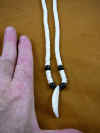
#W-30-3
One coyote tooth (1-5/8" long) on
20" white cow bone bead & black onyx bead necklace, gold rhodium
barrel twist closure
$34
|
 #W-30-4
1-3/4" coyote tooth on 20" black
hematite and orange Carnelian bead necklace
$34
SOLD |
 #W-30-5
1-3/4" coyote tooth on 20" black
hematite bead necklace
$34
SOLD |
 #W-30-6
1-3/4" coyote tooth on 20" black
hematite and red glass bead necklace
$34 SOLD |
 #W-30-7
1-3/4" coyote tooth on 20" black
hematite rice and faceted bead necklace
$34
SOLD |
 #W-30-8
1-3/4" coyote tooth on 20" black
hematite and red glass bead necklace
$34 |
 #W-30-9
1-3/4" coyote tooth on 20" black
hematite and blue turquoise bead necklace
$34
SOLD |

#W-30-10
1-3/4" coyote tooth on 20" black hematite and
faceted red Austrian crystal bead necklace
$34 |
 #W-30-11
1-3/4" coyote tooth on 20" black
hematite and blue turquoise bead necklace
$34 SOLD |
 #W-30-12
1-3/4" coyote tooth on 20" black
hematite and faceted red glass bead necklace
$34 SOLD |
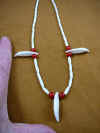
#W-30-13
Three coyote teeth (1-5/8" long) on
20" white cow bone (slim) bead and red glass bead necklace, gold rhodium barrel twist
closure (1 available)
$40 |
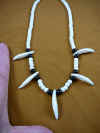
#W-30-14
Five coyote teeth (4 are 1-3/8" long, bottom
tooth is 1-3/4" long) on 20" white cow bone bead & black onyx bead
necklace, gold rhodium barrel twist closure
$46
SOLD |
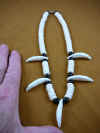
#W-30-15
Five coyote teeth (all 1-5/8" long)
on 18" white cow bone bead (large rondells) and black onyx round
beads, silver rhodium barrel clasp closure (1 available)
$52 |
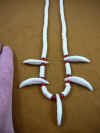
#W-30-16
Five coyote teeth (all 1-5/8" long)
on 20" white cow bone bead (medium rondell) and red round glass
beads, gold rhodium barrel twist closure (1 available)
$44 |
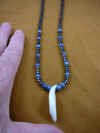
#W-30-17
One coyote tooth (1-3/4") on
20" hematite (small rondell) and New Zealand blue coral round beads,
silver rhodium barrel twist closure
$38
SOLD |
COYOTE
TOOTH + CLAW NECKLACES
Natural coyote teeth from legal hunting, using 100% of the
animal. |
_small.JPG)
_small.JPG)
_small.JPG)
_small.JPG)
#30-100
5 Coyote tooth and 12 coyote claw necklace
Teeth are 1-1/2 long
Claws are 3/4 to 7/8 long
Brown cow bone
bead/faceted golden tiger's eye gem bead necklace 30 long
$95
|
COYOTE
CLAW EARRINGS
Natural coyote claws from legal
hunting, using 100% of the animal. Gold
alloy hypoallergenic French wire earrings
7/8 long (linear measurement)
$15/pr. |

#W30-110 |

#W30-111 |

#W30-112 |

#W30-113 |
| WATER
BUFFALO TOOTH Necklaces
Genuine water buffalo tooth, drilled
and made into a pendant and made into a necklace. They are worn for
STRENGTH and STAMINA (very much like the Water Buffalo itself). The
water buffalo or domestic Asian water buffalo (Bubalus bubalis) is
a large bovine animal, frequently used as livestock in Asia, and also
widely in South America, Southern Europe, North Africa, elsewhere.
There are 158 million water buffalo worldwide, 97% of the population is in
Asia.
Natural teeth may be smooth or have
incomplete enamel but there are no cracks, all are stable & strong.
Teeth are 2-1/4" long, on
20" necklaces, priced as marked |
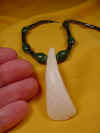
#W35-1
Hematite with green jade beads $38 |
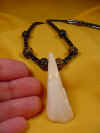
#W35-3
Hematite with pumpkin shaped tiger eye
beads $38 SOLD |
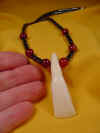
#W35-4
Hematite and orange carnelian beads $38 |
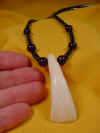
#W35-5
Hematite and purple amethyst beads $38 SOLD |
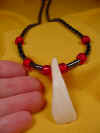
#W35-6
Hematite and red glass beads $38 |
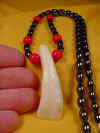
#W35-8
Hematite and opaque red glass beads $38 |
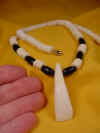
#W35-11
Black and white bone beads $34 |
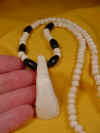
#W35-13
Black and white bone beads $34 SOLD |
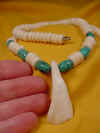
#W35-14
White bone and Chinese turquoise beads
$34 |
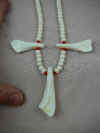
#W35-15
Three tooth necklace ( 1 2-1/4" and 2
1-7/8" teeth) with white bone with red glass beads
$50
|
|
 #W35-21
Black cotton cord necklace with silver tone
beads
$28 SOLD |
| BADGER
CLAW NECKLACE
Stunning look that will have everyone
guessing! Badgers are known for their digging capabilities, now you
can see why! These are natural claws acquired by legal hunting that
uses 100% of the animal. |

#W-40-1 ONE badger claw (1-1/2" long) on
brown beads and Chinese turquoise beads, 20" long $28
SOLD |

#W-40-2 ONE badger claw (1-3/4" long) on
brown beads and jade beads, 20" long $28
SOLD |

#W-40-3 ONE badger claw (1-3/4" long) on
brown
beads and Chinese turquoise beads, 20" long $28
SOLD |
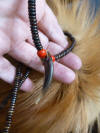 #W40-4
One 2" badger claw on 20" brown bone bead
necklace with red glass accents
$30
SOLD |

#W-40-6 THREE badger claws (one 1-5/8" and two
1-1/4" long) on brown beads and red glass beads, 20" long
$36 SOLD |
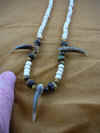
#W-40-7 THREE badger claw (one 1-5/8"
and two 1-1/2" long) on antiqued cow bone
beads and tiger-eye beads, 20" long $38
SOLD
|

#W-40-9 THREE badger claw (one 2" and two 1-1/2" long) on antiqued cow bone
beads, purple amethyst and Chinese turquoise, 20" long $38
SOLD |

#W-40-10 ONE badger claw 1-7/8"
long on antiqued cow bone
beads, purple amethyst and Chinese turquoise beads, 20" long $30 |

#W-40-11 THREE badger claw (one 1-7/8"
and two 1-5/8" long) on antiqued cow bone and green jade beads, 20" long
$38 |

#W-40-12 ONE badger claw 1-3/4"
long on antiqued cow bone
beads, green jade beads, 20" long $30 |

#W-40-13 THREE badger claw (one
1-7/8" and two 1-5/8" long) on antiqued cow bone
beads and red glass beads, 20" long $38
SOLD |

#W-40-14 ONE badger claw 1-7/8"
long on antiqued cow bone
beads and red glass beads, 20" long $28
SOLD |
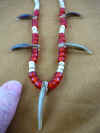
#W-40-15 FIVE badger claw (one 2",
two 1-7/8", and two 1-5/8" long) on antiqued cow bone
beads and red glass beads, 20" long $46
SOLD |
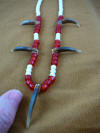
#W-40-16 FIVE badger claw (one
2-1/8", two 1-7/8", and two 1-5/8" long) on white cow bone
beads and red glass beads, 20" long
$46 |
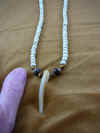 #W-40-18 ONE RARE white badger claw 2"
long on antiqued cow bone
beads and tiger-eye beads, 19" long
$36
|
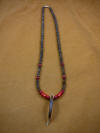
#W40-21
ONE CLAW NECKLACE, One 2-1/8 claw on 20 brown cow bone bead, red bamboo
coral beads (round & bamboo shapes) with gold tone barrel twist closure
$36
|
|
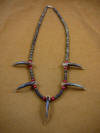
#W40-22
FIVE CLAW NECKLACE, One 2-1/8, four 1-3/4 claws, on 20 brown cow bone
bead necklace with red coral accents, gold tone barrel twist closure
$52
SOLD
|
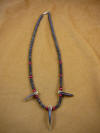
#W40-23
THREE CLAW NECKLACE, One 1-7/8, two 1-3/8 claws, on 20 brown cow bone
bead, round red bamboo coral bead necklace, gold tone barrel twist closure
(6
available)
$38
|
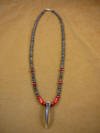
#W40-24
ONE CLAW NECKLACE, One 2 claw on 20 brown cow bone bead, red bamboo
coral beads (round & bamboo shaped) necklace, with gold tone barrel twist
closure
(6
available)
$32
|
|
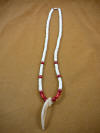
#W40-25
ONE CLAW NECKLACE, One 2-1/8 claw on 20 natural cow bone, red
bamboo coral (round & bamboo shaped) beads, gold tone barrel twist closure
(5
available)
$36
|
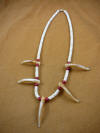
#W40-26
FIVE CLAW NECKLACE, One 2-1/8, four 1-7/8 claws, on 20 natural cow
bone and round red coral bead necklace, gold tone barrel twist closure
(2
available)
$52
|
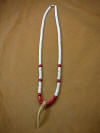
#W40-27
ONE CLAW NECKLACE, One 2 claw on 20 natural cow bone bead, red
bamboo coral round & bamboo shaped bamboo coral beads, gold tone barrel
twist closure
(5
available)
$34
|
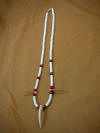
#W40-28
THREE
CLAW NECKLACE, One 2 and two 1-5/8 claws on 20 natural cow bone beads,
round red bamboo coral beads, gold tone barrel twist closure
(8
available) $44 |
|
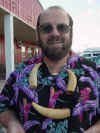
SPERM WHALE TOOTH NECKLACE
FROM
FIJI TRIBAL CHIEFTAIN,
worn by a smiling Glenn !
Glenn
acquired this very rare FIJI TRIBAL CHIEFTAIN NECK PIECE from a
lady that owned a small museum located in Glenalg, just outside of
Adelaide, South Australia, while he was visiting Rodney Fox the world
renowned shark expert in March of 1993. This was quite the
conversation piece at dinner one night at the Fox's. It is made of
three sperm whale teeth measuring 7", 5.5", and 5", with
an etching or hieroglyphics on the largest (bottom) tooth. The
museum owner's husband was presented this piece in the early 1940's
while visiting Fiji to acquire native art objects for their
museum. Glenn acquired this at the time the museum was liquidating
its collection due to the owner's failing health after her husband's
death.
Glenn
has a reputation for finding the strange and unusual items that he has
in his collection from his worldly travels to 54 different countries.
Rodney was amazed that this item was right here in his own town. It just
goes to show you that treasures can be found right in your own back
yard.
Glenn
has since attempted to find a museum back in Fiji that would like to
acquire this for their collection, but to no avail, as he was told there
were no funds available for such an acquisition of this nature.
When found, these items are several to tens of thousands of dollars.
Valued
at $4800.00 but not for sale
|
| OUCH!
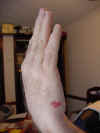

The ultimate Valentine's Day "Gift",
Glenn was using the hot glue gun and accidently touched the side of his
hand into two drops of hot glue which made a heart, around Jan. 31, 2004,
close enough to Feb. 14 to make it an interesting coincidence.
|
| THE
HOUSE THAT WALKED.. |
|
  
This is a house made entirely of genuine DINOSAUR BONE! No
kidding! It's in Medicine Bow, Wyoming. Look on either side of the
"Fossil Cabin" sign for dinosaur leg bones that are the most obvious,
but we checked it out and it's for real! Ripley's calls it the
"Oldest House in the World", the house that "walked 175 million
years ago". Is that cool or what?
|
| MR.
TURTLE |
|




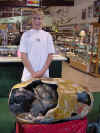
This is a GIGANTIC 650 pound carving of a dragon turtle within the boulder, still
attached inside! Chinese artwork, estimated circa 1950's by Tsui Tsan Pin
of Chekiang Providence. Measures about a
yard long, 18" wide and high. WOWS every single person that stepped into
our store (we no longer have a storefront, he now graces the foyer of our home
as you can see on our home page). Detail of carving, natural color contrasts from outside to
inside of boulder (Chinese native soapstone) and sheer SIZE commands your
attention! We call it "The Ancient One". Extremely
important good luck symbol for the Chinese - they generally leave
money at his feet and sometimes bow and back away when leaving. The dragon
turtle is also considered an important feng shui symbolism. It was carved
in an isolated area in the Province of Chekiang.
Valued at: $28,000
(this is in our personal collection, not for sale)
If you enjoy Mr. Turtle as much
as we do, you can now purchase a reconstituted marble, molded mini version
that is REMARKABLE on our Gem Animals page 5, click here: Gem Animals Page 5
|
| SHRUNKEN
HEADS |
|


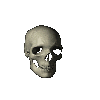
Shrunken
heads from Ecuador (actually it's goatskin that's been dampened and stretched over a
wooden face form where it shrunk and dried, was cut away from the form, and hair
shaved away, lips sewn shut. Pretty weird, wouldn't you say?) Here's
more photos of museum quality goat skin shrunken heads we have handled in
the past:
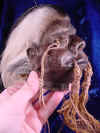
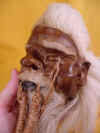
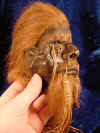
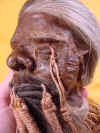
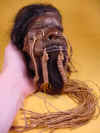
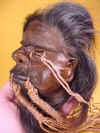
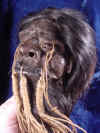
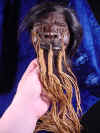 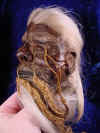
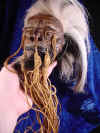
We
no longer sell Shrunken Heads, but we recommend you go to this site to
buy:
http://www.salangome.com/
|
THERE REALLY ARE SHRUNKEN HEADS, BUT THEY'RE IN MUSEUMS
Shrinking a head to the size of a baseball is a grisly but
fascinating custom. The people of South America known as the "Jivaro"
in Ecuador, Peru and Brazil are well known for shrinking the heads of their
enemies. This practice dates back to 200 B.C. Raids on alien tribes
are carried out specifically to secure "tsantsas", or shrunken head
trophies. The attacks are usually small and carried out on one house where
the victim may be caught unawares. Although the heads of men, women and
children are taken, it is more frequently an adult warrior's head that is
sought. The trophies bring prestige to the head takers and trap the
"avenging" or "miusak" souls of their victims, giving the
taker power and prevention of vengeance against them.
The first step is the removal of the head. The skin is cut
around the top parts of the chest and back, and the head is cut off close to the
collar bone. The head taker then passes a vine through the head to carry
it, and makes a fast retreat. The head is prepared over 5 or 6 days during
brief stops on the return home. A slit is made in the back of the head, and
the skin is carefully removed from the skull. The skull is thrown into the
river as a "gift to the anaconda". The skin is then boiled in
plain water or an herbal solution for half an hour. By now it is half its
original size. It is then placed over a stick and left to dry.
The skin is now turned inside out, and any remaining flesh is
scraped away. It is turned right side out again, and the slip in the back
is sewn together and the mouth is tied shut, sometimes the eyes being sewn shut
as well. Several small rocks are heated in a fire and placed into the
skin. They are rolled around inside until cool, dumped, and the process is
repeated until the tsantsa has shrunk too much to accommodate the stones.
Hot sand is used to continue the shrinking. It may be hung over a smoldering
fire overnight which turns the color from yellowish to black.
It may be polished with ash as well. At this time, the head is shaped and
a hot knife pressed against the mouth to dry it. Throughout the shrinking
process, the neck must be drawn closed with a string that has been sewn through
it, so it will remain proportionate to the head.
The warriors enter the home village with the shrunken heads tied
around their necks. Then the tsantsa rituals begin again...there was a
time when these warriors found a commercial gain from selling the heads, and
made forays to other tribes for this purpose. Governments worldwide wisely
banned the sale or purchase of real shrunken heads, except for the purpose of
display in limited museums.
So now you know the story of the REAL shrunken heads!
|
Ripley's Believe it or Not Museum in Myrtle Beach, SC,
a genuine shrunken head:

I apologize for the low quality of the picture, but it was quite dark - I should
have used a flash! But you get the idea. Ripley's owns the largest
collection of genuine shrunken heads in the world.
|
|
Here's a better photo
of a REAL shrunken head...
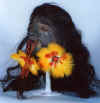
There's even a comprehensive book
available now about genuine shrunken heads (runs about $75) that can be obtained
from the Malter Galleries Inc. (go online to find the company).
Finally, if you want to see MORE
REAL SHRUNKEN HEADS...
http://www.angelfire.com/id2/tower7/BwanaMuseum.htm
|
|


This
is an old buffalo vertebrae with a genuine Indian arrowhead protruding from the
spinal column. Good shot!
$135.00 SOLD
|
| DEFORMED
ALLIGATOR HEAD COLLECTION
Now individually photographed for
sale, link below |
|


 

Three-eyed
Wally - our freeze-dried gator head from the bayous in Louisiana (part of our
personal collection, this one is not for sale).
Deformities such as this (a Siamese twin - see the extra upper jaw? --even
an extra hole where the 4th eye would have been?) occurred when the oil
companies in the 1930's took the byproduct of oil (dioxin), put it in barrels
and buried it in the swamps. It leaked into the water and caused this and
other oddities.
Glenn actually has about 380 heads in the collection
that documents this pollution by man. We can
learn from this! See more close up
photos of the collection on the Gators page 6

|
| OOSIK
- WHAT'S AN OOSIK? |
|

Fossilized
juvenile walrus oosik, polished, 9" long. (penis bone). Some animals, such as seal, sea lion,
polar bear, walrus and raccoon do have a real bone, as you see. How odd is
that? SOLD. More available on the Oosiks
page (Fossils page 6).
|
| STUFFED
OSTRICH CHICK |
|

This is a REAL ostrich chick, taxidermied when it died at birth at
an ostrich farm in California. It is mounted on a composite base with the
egg, and is 17" long x 10" wide x 7" high. SOLD
3/18/02. We'll leave the picture for you to enjoy!
|
| ONE
OF THE WEIRD COLLECTIONS IN THE STORE WE HAD (now our home is called the
Weird Museum, I wonder why?) |
|
   
This is one of our oddity displays in our store to give you an idea of what
we have - FIRST photo - a genuine dinosaur egg, mud concretions
from a glacier, strange stones formed by lightning, deformed gator feet & our
famous 3-eyed Wally gator, also a blind gator;
SECOND photo - Pre-Columbian terra cotta necklaces and also
beads used in their SLUG worship, human tooth beads; and..are those REAL modern
human teeth there?..only the store owners know for sure...then there's our buffalo vertebrae with the arrowhead
through to the spinal column, and fossil tree branches from Alaska;
THIRD photo - Our famous Mugwump formation from Area 51
(inverted, it was caused from rainfall that solidified the sand into a type of
concretion - but we like to think it was an alien creation to keep the mystery
alive!); also our menacing black scorpion, and the emerald beetle made into
jewelry after it's eaten.
FOURTH photo - Our Sperm whale tooth chieftan's necklace with
etchings made by the natives, and giant stingray barbs (fresh) from Australia.
We've got another large display of identified fossils, (see
Fossils pages) and another of unusual gemstones (Rocks & Minerals
pages).
|
| Venus
GLASS SPONGE |


You'll never guess what this is in a million years! .... give up? It's
the bleached skeleton of a GLASS SPONGE called the Venus Flower Basket (Euplectella
aspergillum, phylum Porifera), belonging to a small group of glass sponges
(Hexactinellida).
This sponge lives 1500 to
15,000 feet under the waters of the western Pacific around the Phillipine
Islands and Japan. With a cruel twist of fate, pairs of small shrimp (spongicola)
swim through the sieve in the top into the "bridal chamber" and enjoy
meals that come through the sieve. However, the shrimp couple grow too
big to get out - the home becomes a jail - but they live happily there,
producing young that leave the "home" and find a sponge of their own
with their own "bride" or "groom". The shrimp couple dies together in the sponge, so it becomes their
burial coffin as well.
For centuries, this skeleton of the glass sponge, with
its pair of tiny dried shrimp imprisoned inside, was prized as a wedding gift in
Japan. Newlyweds regarded it as a symbol of a long life together into old
age and into the same grave.
One of the more unusual "wedding
gifts" we've seen!
How does it form this glass? The sponge extracts
silicic acid from seawater and converts it into silica, then forms it into
an elaborate skeleton of glass fibers. The sponge's low-temperature
process for creating and arranging such fibers may be a useful technology
in the fiber optics industry, due to the fact that only high temperature
methods are used in this industry now.
RARE LARGE SIZE of
between 8 and 10-1/2"; there is a
natural mud/sand base where it was removed from the sea floor;
considerable variation in curvature and how it stands on the table or lays
down. Suitable for display in a glass dome or low two-prong display
stand (not included).
(We were erroneously told a few months ago
that these were endangered, however, they are NOT endangered, they are
thriving well.)
individually
photographed |
| AVERAGE
7 to 8" long
$32 ea |

#W80-1 |

#W80-2 |
|
|

#W80-7 |
|

#W80-11 |

#W80-12 |
| LARGE
9 to 10" long
$37 ea |

#W80-48 |

#W80-49 |

#W80-50 |

#W80-51 |

#W80-52 |

#W80-53 |

#W80-54 |

#W80-56 |

#W80-57 |

#W80-58 |

#W80-60 |

#W80-61 |
| TRUE
HEART COCKLE SHELL |



#W-90
TRUE HEART COCKLE SHELL
(Corculum cardissa)
An amazing, delicate-looking but extremely sturdy shell in the natural
shape of a heart, often given as an appropriately romantic gift. The
family Cardiidae is one of the largest and best-known of bivalves. There
are over 200 living cockle species and many more fossil forms.
Strong, compact, and heart-shaped, the cockle
shell can be rolled over the sands and banged about without any damage to
the live mollusc. Its siphons are short, and the foot is also well
developed --indeed capable of moving the animal about in short leaps at
the surface, where it normally lives. In many cockles, the siphons also
bear light receptors.
-
- Shell features are: completely symmetrical
and equal sized valves; prominent umbones; strong radial ribs, which
in some species carry spines; equal size muscle scars; no pallial
sinus; and, two cardinal teeth in each valve. The internal margin of
the lip may vary from lightly serrated to the definitely crenulated
edge view, shown in the two species at right.
- Found: Indo-Pacific
- Classification: Bivalvia
- Subclass: Pteriomorphia
- Order: Veneroida
- Superfamily: Cardiacea
- Family: Cardiidae
One of my favorite
shells, a lovely natural heart shape. It is quite flat
with a bulge in the center, totally flat on the back, really no opening to
speak of.
$4.50 each
(free shipping) |
| RARE!
A WHOLE TEAK TRUNK of ELEPHANTS
#W-182. This tree trunk of
solid teak is NINE FEET long x Two feet high x 5 to 11" thick
variation. It was carved in Thailand with 20 elephants, all still
part of the tree trunk. We estimate its weight at 300 pounds. We
have mounted it on our bedroom wall on a custom made oak book case with a
solid wood top to support its weight:



Valued at $7,800 but not for sale |
| To
accompany the elephant teak log, we purchased this two elephant head
carving (also of teak) that even has EYELASHES on it, it is stunning (not
for sale):



|
|
BRAIN
CORAL

#W-183. (continued from above). Behind every BRAIN, there's a (hmmm)...a YOU-KNOW
WHAT! I'm sure we'll get a lot of mileage out of this highly unusual,
natural specimen of brain coral, don't you think?
Valued at $275.00 but not for sale
|
| MUSHROOM
CORAL |


(Fungia
Scutaria), also called Plate coral or Fungus coral.
This beautiful specimen Heidi received by trading items with a
friend. It is 13" long. Neat.
|
| FOSSIL
MUD |
|
FOSSILIZED MUD from the GREAT LAKES of the MIDWEST


#W-184. Formed when mud oozed into a bubble formed
under the glacial ice, then hardened and fossilized into this bubble
shape. Photos show top and bottom. Measures 4" x
4-3/4" x 2".
$35.00
SOLD |
| The
answer to the weird thing in the yellow box above?

It's a genuine
ALLIGATOR
TONGUE.
Remember, when alligators are legally hunted and processed, 100% of it is
used. Nothing is wasted. These are often made into WALLETS. |
|
Our latest mystery SOLVED-SEE BELOW
Here's a common Queen Anne's Lace
weed, photo sent by Tobi in Ohio.

She relates: "The flowers grow wild
everywhere and have big, flat heads with tons of tiny petals on top.
I was walking one day and found one that was fluorescent orange. I
picked it because I was afraid they would come mow and it would be lost.
It almost looked like it had been spray painted, but closer inspection
showed it was the real color. I called a botanist at the University
of Akron about it, but no one returned my call.
The second flower down on that stalk was already showing the same orange color,
but more muted. I don't know what could be in the soil, it is near buried
power lines, and close to a natural wetland area. When I looked it up in
the flower book and saw that it was in the carrot family
Anyone know what in the soil would cause this, or is
this just a natural variation? |
| SOLVED,
thanks to our great customer SANDRA. She relates: "Being an
avid gardener and having had past love/hate relationships with Queen
Anne's Lace, I was surprised by the color myself. I've seen very
light pink but not orange. I'd be interested in finding something
like that someday and saving the seeds. I might fall in love with
Queen Anne's Lace again!
I've always thought
you and Glenn must have the best jobs on the planet. Sure it's work
but just the experiences and learning...makes my mind spin!" (Indeed
we feel lucky, Sandra, and we learn from our customers every single
day. Thanks! Heidi)
She also gave links to
the Carrot Museum for further investigation:
http://www.carrotmuseum.co.uk/qal.html
The curator responded likewise, adding that the wild carrot in the
U.S.A. did appear and colonize from the seeds of cultivated carrots
brought by the settlers spreading into the countryside and eventually
turning back to their wild form, so I can only guess it could be a throw
back. But if this is so, then it does not stack up with current
carrot flowers, irrespective of their root color, always being
white. It could be something in the soil nutrients. |
| MYSTERY
SHELL!
Our friend Hal brought us a framed set of two
shell specimens that no one in the Fossil Shell club here in Myrtle Beach
can identify. It was found on the Atlantic shore of North Carolina,
both are about 5" long, the operculums intact on both.
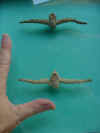

 
2/24/07
update! Research by one in the Myrtle Beach Fossil Club brought up
the following: It is a
Hippoporidra-edax Bryozoa/Cleidochasmatidae
(found 120 to 180 feet in Florida waters. Hermit crabs live in
them). Here's a link to a photo of that specimen found through
internet research: http://www.specimenshells.de/bilder/bryozoa/edax_1749.htm Great
sleuthing! |
This is a rare BUSYCON
CANALICULATUM CHANNELED WHELK. The rare part is that it
is LEFT-HANDED (or sinistral). It measures a linear 6-1/4" long
x 3-3/4" wide. It just sold for $380, we are honored to have
been part of the transferrance of this rare item to an appreciative new
owner.
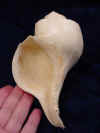 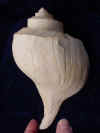

 
Here is a photo of the usual Right-handed
Channeled whelk in the Seashells of North America book:
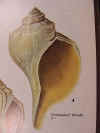
The only left-handed
whelks we know of are the Lightning Whelk and the Perverse Whelk, as shown
in this publication: "Seashells of North America":
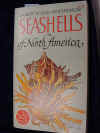

We sold it for $380 to Mark in
Charleston. Here is Hal, a friend of Helen Tilley who owns the
shell, transferring it to Heidi to ship out to Mark today (2/27/07.

|
| 10/05/08
TODAY'S MYSTERY?
Friends found these bones on the shores of an
island near Myrtle Beach SC. Are the turtle plastrons (belly bones)
or what? They measure 3-5" across.

If you know for sure, give us a shout!
====================
MYSTERY SOLVED, THANKS TO TOM
This website shows many pictures and sketches
of very similar plastrons.
http://www.oceansofkansas.com/Turtles.html
http://www.oceansofkansas.com/Turtles/hayarch1.jpg
You can see that what they found were two Hyo plastrons and one
Hypo. Now,
from what species of turtle these are, I do not know.
A detailed website for ANYONE interested in
turtles.
THANKS TOM!
|
But on the next page is our BLUE RIBBON WEIRDEST DISPLAY...
Click To Go To:
The Weirdest Page 2 Page
3 Page 4
|